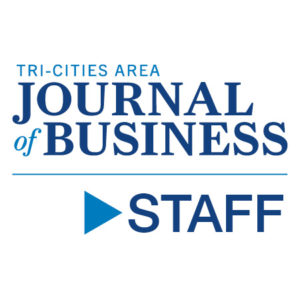
Home » Architecture & Engineering Briefs – January 2022
Architecture & Engineering Briefs – January 2022

January 12, 2022
AIA Central Washington honors best of 2021
AIA Central Washington, representing the region’s architects, honored three projects with its 2021 Design Awards in November.
EB Architecture + Design of Portland received the Honor Award for its High Prairie Residence. The residential project in Lyle, north of the Columbia Gorge, is described as a “modest getaway” offering simple comfort in a dramatic setting overlooking volcanic peaks.
The project was completed in late 2019. The 1,600-square-foot house and 864-square foot garage were built by Paul Carloss Construction, with structural work designed by Grummel Engineering.
KDA Architecture of Yakima won the Citation Award for its YMCA & Yakima Rotary Aquatic Center project. It partnered with ALSC Architects on the 66,000-square-foot facility.
The aquatics and fitness center was the joint venture between the city and the YMCA.
The building welcomes visitors with a sweeping glass wall. Inside, users can access a lap pool, heated therapy pool, lazy river, water slides, beach entry play area, wellness center, indoor running track, gymnasium, yoga deck and child care.
Graham Baba Architects of Seattle received the Craftsmanship Award for its Orchard Canyon project.
The 6,000-square-foot, orchard-set residence sits on a 20-acre site at the edge of a canyon. The long, glass-and-stone building is designed to accommodate public and private events hosted by its owners. The side entry features a cascading water feature. The master suite is cantilevered away from the main structure and is anchored by a stone fireplace.
Demand for design services continues to grow
Architecture firms reported increasing demand for design services for the tenth consecutive month in November, according to a recent report from The American Institute of Architects.
The Architecture Billings Index, or ABI, score for November was 51, down from 54.3 the previous month. While this score is down slightly from October’s score, it still indicates positive business conditions overall (any score above 50 indicates billings growth).
During November, scoring for both the new project inquiries and design contracts moderated slightly, but remained in positive territory, posting scores of 59.4 and 55.8 respectively.
“The period of elevated billing scores nationally, and across the major regions and construction sectors seems to be winding down for this cycle,” said AIA Chief Economist, Kermit Baker. “Ongoing external challenges like labor shortages, supply chain disruptions, spiking inflation, and prospects for rising interest rates will likely continue to slow the growth in firm billings in the coming months.”
Key ABI highlights for November include:
- Regional averages: Midwest (57.6); South (53.7); West (50.9); Northeast (45.5)
- Sector index breakdown: mixed practice (56.9); multi-family residential (51.4); commercial/industrial (50.5); institutional (50.1)
The regional and sector categories are calculated as a three-month moving average, whereas the national index, design contracts and inquiries are monthly numbers.
PNNL engineers 3 devices that win national awards
Three innovations developed at Pacific Northwest National Laboratory have been named winners in the 2022 Federal Laboratory Consortium for Technology Transfer Awards.
A PNNL-developed airport security device that scans passengers’ shoes earned the Interagency Partnership Award; an injector that delivers nutrients to trees received the Excellence in Technology Transfer Award; and a home energy efficiency assessment tool received the Impact Award.
The awards are among the most reputed honors in the technology transfer field, recognizing federal laboratories and their industry partners for technology transfer achievements. PNNL has received 98 FLC awards since the program’s inception in 1984.
- Shoe scanner: The Millimeter-Wave Shoe Scanner uses imaging to detect concealed objects in footwear. It could potentially be integrated into the floor of a body-scanning portal, which PNNL also developed. Anyone who travels can recognize the potential benefit: Passengers would not need to remove their shoes to pass through airport security, reducing a bottleneck in screenings. PNNL partnered with the U.S. Department of Homeland Security, Science and Technology Directorate to build the shoe scanner. The scanner builds on PNNL’s pioneering research in optical and acoustic holography dating back to the 1960s. Scientists and engineers determined how to use millimeter waves to penetrate clothing and scan for concealed objects, resulting in commercial body scanner systems.
- The Tree Micro-Injector: The device delivers nutrition, pesticides and fungicides faster and easier than similar commercially available injectors. It resembles a laboratory syringe, with an exterior housing holding a uniquely designed compressible pod. The single-use disposable pod can be prefilled with a variety of specialty formulations, such as nutrition fertilizers, pesticides, fungicides or plant growth regulators. PNNL partnered with two companies to develop the Tree Micro-Injector.
- Home Energy Score, or HEScore: It is a free, web-based tool for homeowners who want to monitor the energy efficiency of their homes. HEScore generates a customized rating for a home’s energy use. The scoring tool translates home facts–square footage, number of rooms and heating/cooling systems – into a numerical rating of its energy performance compared to other homes. The website, the first tool of its kind, has been under development since 2012. Starting in 2015, PNNL, Lawrence Berkeley National Laboratory and the National Renewable Energy Laboratory collaborated through 2021 to improve the design. HEScore users include homeowners, buyers, renters, energy auditors and software developers.
PNNL partnered with researchers at the National Renewable Energy Laboratory and Lawrence Berkeley National Laboratory for the entry.
Business Briefs Architecture & Engineering
KEYWORDS january 2022





